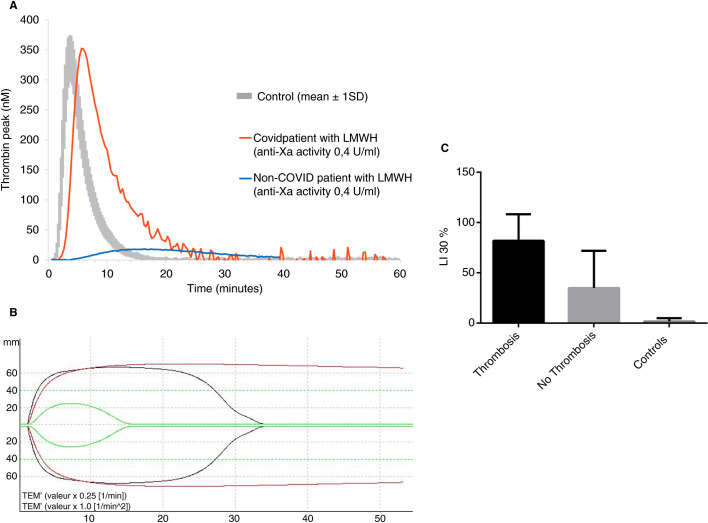Figure 1.
Thrombin generation and TEM‐tPA results in Covid‐19 patients. A, Representative thrombin generation curves of a Covid‐19 patient receiving high‐dose LMWH prophylaxis (subcutaneous enoxaparin 40 mg BID, anti‐Xa activity 0.4 U/mL, red curve), and an obese patient without Covid‐19 infection at high risk of thrombosis, receiving the same treatment (subcutaneous enoxaparin 40 mg BID, anti‐Xa activity 0.4 U/mL, blue curve). The normal range of thrombin generation is represented in gray (mean ± 1 SD). Despite an overall correlation between anti‐Xa and ETP levels (P = .02; Spearman correlation test), the majority of Covid‐19 patients on prophylaxis with LMWH had normal or increased ETP (1670 ± 554 nmol/L/min [mean ± 2 SD]). Among 78 patients included in the study, 30 (38.5%) had an ETP above the reference range, 37 (47.4%) in the reference range, and 11 (14.1%) below the reference range. In vitro spiking of a plasma sample of a Covid‐19 patient with increasing concentrations of LMWH showed effective anticoagulation with expected anti‐Xa and ETP levels with high doses of LMWH (1 anti‐Xa U/mL). Taking together these results strongly suggests that patients with Covid‐19 infection were profoundly hypercoagulable at baseline. B, Representative TEM‐tPA curves from a normal control (green curve), a Covid‐19 patient with thrombosis (red curve), and a Covid‐19 patient without thrombosis (black curve). MCF corresponds to the maximal amplitude and reflects coagulation capacity of the patient. In Covid‐19 patients, MCF is increased. Ly30 is the lysis index at 30 minutes, which is very high in Covid‐19 patients with thrombosis and lower in other Covid patients. C, Ly30 results in Covid‐19 patients with and without thrombosis, compared with controls

